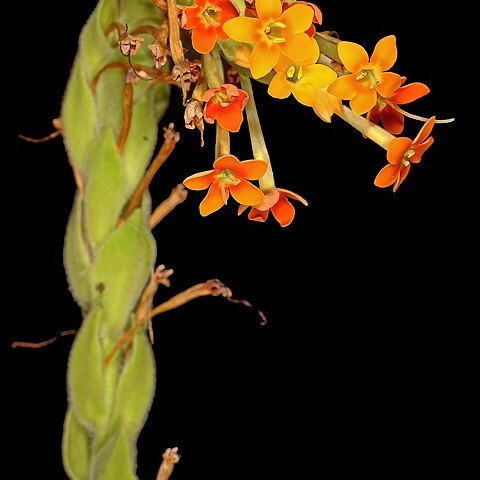Perennial herb, stems one or several from the crown, erect or decumbent then erect to c. 450 mm, usually simple, occasionally forking once or twice above or below, sometimes with a few short, slender (sterile?) branches near the base, pubescent with short gland-tipped and long acute hairs, closely leafy. Leaves opposite below becoming alternate upwards, mostly 20-65 x 4-15 mm, decreasing in size upwards; radical leaves (often wanting at flowering) elliptic, obtuse, narrowed to a petiole-like half-clasping base; stem leaves oblong to elliptic-oblong, scarcely narrowed below, sessile, clasping, obtuse to subacute at apex, entire or obscurely toothed to crenate or serrate on margins, thick-textured, upper surface pubescent with acute and gland-tipped hairs, lower similar or hairs confined to main veins and margins. Inflorescence turbinate initially, c. 30-100 mm long, rapidly becoming oblong, nearly always solitary, rarely with subsidiary heads, elongating in fruit. Bracts 12-19 x 7-17 mm, ovate, acute and apiculate or obtuse, entire, pubescent outside with acute and gland-tipped hairs, minutely glandular-puberulous inside. Calyx 5-7(-8) mm long, thin, membranous, obscurely bilabiate, lobes free nearly to the base or fused up to 1/3-1/2 their length,-free to the base anticously, delicate hairs on bracts and margins, many gland-tipped. Corolla tube 20-29 mm long, c. 1.25 mm broad, slightly dilated under the limb, creamy; limb nearly regular, 7-9 mm diam., lobes suborbicular, orange to orange-red inside, creamy outside. Stamens with anthers markedly unequal, posticous pair with long vertical anthers, included, anticous pair with short horizontal anthers, exserted. Capsule c. 7-8 x 34 mm, seeds many, c. 1 x 0.7 mm Flowering between October and July but mainly in December and January.
More
Perennial herb, 0.45 m high. Stems 1-several, weakly branched, closely leafy; with short gland-tipped and long acute hairs. Leaves initially opposite becoming alternate; basal ones elliptic, 20-65 x 4-15 mm, apex obtuse, base narrow to petiole-like half, clasping at base, becoming elliptic-oblong and sessile, apex obtuse to subacute, margins entire or obscurely toothed to crenate or serrate. Flowers: in heads, obconical at first, elongating to 30-100 mm long in fruit, mostly solitary; stamens markedly unequal; corolla with tube 20-29 mm long, dilated under limb, cream-coloured, limb suborbicular, orange to orange-red outside and cream-coloured inside; Oct.-July, but mainly Jan., Feb. Hybridises with G. nutans.
Perennial herb, erect or decumbent, then ascending, up to 450 mm long; stems single or several, little branched, closely leafy. Leaves up to 65 x 15 mm; basal, if present, rosulate, elliptic, obtuse; cauline ± oblong, ± entire. Flowers in heads, obconical at first, up to 100 mm long, then oblong, usually single, lengthening in fruit. Calyx: lobes free or somewhat joined, divided to base on anticous side. Corolla: tube 20-29 mm long, cream-coloured; limb ± regular; lobes ± circular, bright orange to orange-red inside, cream-coloured or white outside. Flowering time Jan., Feb., June.

